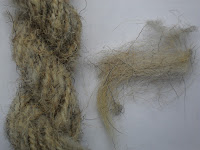Bluefaced Leicester
Leicester
longwool Breed
Staple7.5-15cm
Micron 24-28
About Bluefaced Leicester sheep: The blue face comes from the very fine white hairs
over the dark black skin creating the visual illusion of a blue hue. They also
have erect ears and wool is tightly purled, fine and semi-lustrous. The
Bluefaced Leicester (Pronounced Lester)
sheep evolved in Northumberland in the early 1900’s as direct descendants of
the now extinct, Dishley Leicester. They were first brought over to Canada in
1970. The BFL is also one of the largest British breed sheep.
My Spinning experience:
There seems to be 2 kinds of spinners
where BFL is concerned. One is those who love spinning BFL and one is those who
love spinning BFL. My previous
experiences with BFL have been with top or dyed roving. Did you know that top
is fiber all lined up perfectly in the one direction and just by dyeing top, it
is no longer top? Through the dyeing process, no matter how careful, the fiber
is no longer perfectly aligned, making it roving. I’d personally take this fact
to the bank as it was told me at a workshop by Judith MacKenzie.
Anyway, back to the BFL.
So, my experience till now was primarily of top or roving (and will be for
quite some time with it constituting a good 25% of my stash). BFL is a lovely
fiber that dyes beautifully and blends exceptionally well with fibers like
silk. My lock spinning experience was also a pleasant one. If spinning top, make sure to fluff it out a
bit to allow easy drafting without it grabbing and running away from you in a
clump. Spinning from the lock was a breeze. The finished yarn shows lovely
stitch definition and is lovely as next to skin soft for knit/woven garments.
Badger
Faced Welsh Mountain
Staple:
7.5-10cm
Micron:
26-37
About Badger Faced Welsh Mountain Sheep Have
roamed the Welsh hills for centuries but only reached , recognized breed status
in 1976, the same year that Peter Casserly of New Zealand hand sheared a record
353 lambs in 9 hours (he also sheared Shrek) and The Donnie and Marie Show debuted on the
tube. They, the Badger faced sheep and not Donnie and Marie, were also used as markers on hills for shepherds to locate
their flocks. There are 2 distinctive type of badger Faced Welsh Mountain
sheep. Torddu (pronounced Torthee)
has a dark belly, face markings and a light coloured fleece. It is 3 times more
numerous than Torwen and considered The Badger. The other, Torwen has a white belly, face markings
and dark fleece.
The breed is primarily a
meat sheep though the fleece was processed locally, dyed and woven into the
famous Welsh red cloaks.
My Spinning Experience:
My Torddu sample was sooo interesting looking in the wee
baggie. I only wish I left it in there! The colours are stunning in their
range, especially within the [i]kemp
which gave me an incredible looking yarn but too prickly for next-to-skin wear.
Anyway, my sample included everything from short fibers to even shorter second
and likely 3rd cuts. Kemp of every colour and bits of absolutely
everything the sheep came into contact with. It was obviously a happy sheep as it
must have roamed near and far, being so filthy. The fiber was quite dry (little
to no lanolin/grease) but no way it could have been cleaned. Surely. With such
short fibers I had to spin this one a little longer draw.
After the Torddu….it was
clearly evident that my breed stash needed restructuring and my floor, wheel
and clothes, cleaning. I needed a wine.
My resolution:
Pile 1:Commercially
prepared and ready to spin fiber and/or locks
Pile 2: Looks clean but
needs carding
Pile 3: The raw and
I-haven’t-a-clue-what-to-do-with-that pile
[i] Kemp:
The heaviest, coarsest hair fibers. They do not accept dye and can be prickly
in the resulting yarn. Kemp is not desirable in a fleece for hand spinning but
does create a tweedy effect.



No comments:
Post a Comment